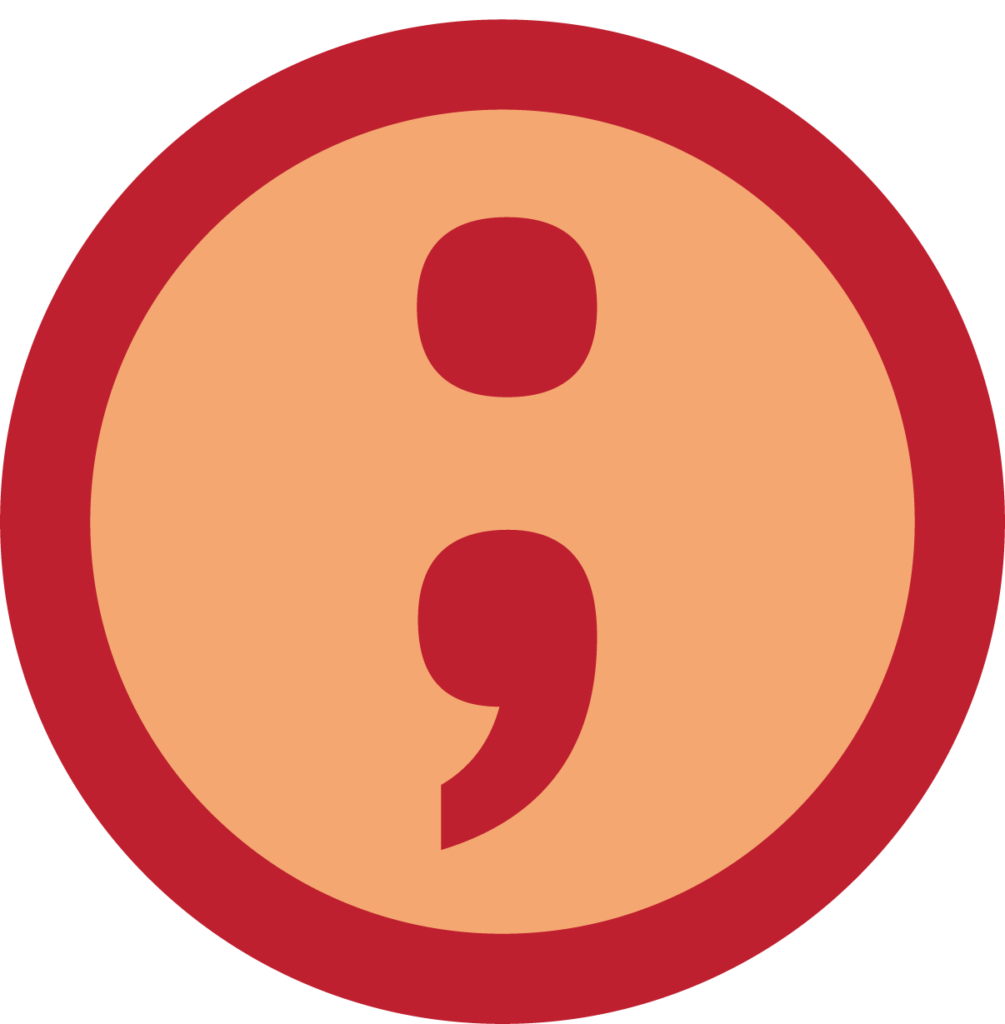Semicolons

The semicolon is one of the most misunderstood and misused punctuation marks; in fact, it is often mistaken for the colon (which we’ll discuss next). However, these two punctuation marks are not interchangeable. A semicolon connects two complete ideas (a complete idea has a subject and a verb) that are connected to each other. Look at this sentence for example:
Anika’s statue is presently displayed in the center of the exhibit; this location makes it a focal point and allows it to direct the flow of visitors to the museum.
The first idea tells us where Anika’s statue is, and the second idea tells us more about the location and it’s importance. Each of these ideas could be its own sentence, but by using a semicolon, the author is telling the reader that the two ideas are connected. Often, you may find yourself putting a comma in the place of the semicolon; this is incorrect. Using a comma here would create a run-on sentence (we’ll discuss those more in Text: Run-on Sentences). Remember: a comma can join a complete idea to other items while a semicolon needs a complete idea on either side.
The semicolon can also be used to separate items in a list when those items have internal commas. For example, say you’re listing a series of cities and their states, or you’re listing duties for a resume:
- As a photographer for National Geographic, Renato had been to a lot of different places including São Paulo, Brazil; Kobe, Japan; Kyiv, Ukraine; and Barcelona, Spain.
- As an engineering assistant, I had a variety of duties: participating in pressure ventilation surveys; completing daily drafting, surveying, and data compilation; and acting as a company representative during a roof-bolt pull test.
Colons
 The colon: well-loved but, oh, so misunderstood. The colon is not just used to introduce a list; it is far more flexible. The colon can be used after the first word of a sentence or just before the final word of a sentence. The colon can also be used to introduce a grammatically independent sentence. Thus, it is one of the most powerful punctuation marks.
The colon: well-loved but, oh, so misunderstood. The colon is not just used to introduce a list; it is far more flexible. The colon can be used after the first word of a sentence or just before the final word of a sentence. The colon can also be used to introduce a grammatically independent sentence. Thus, it is one of the most powerful punctuation marks.
The colon is like a sign on the highway, announcing that something important is coming. It acts as an arrow pointing forward, telling you to read on for important information. A common analogy used to explain the colon is that it acts like a flare in the road, signaling that something meaningful lies ahead.
Use the colon when you wish to provide pithy emphasis.
- To address this problem, we must turn to one of the biologist’s most fundamental tools: the Petri dish.
Use the colon to introduce material that explains, amplifies, or summaries what has preceded it.
- The Petri dish: one of the biologist’s most fundamental tools.
- In low carbon steels, banding tends to affect two properties in particular: tensile ductility and yield strength.
The colon is also commonly used to present a list or series:
- A compost facility may not be located as follows: within 300 feet of an exceptional-value wetland, within 100 feet of a perennial stream, or within 50 feet of a property line.
Practice
Are the semicolons and colons used correctly in the following sentences? Write your corrections and comments in the text frame below. The sentences have been numbered to aid in your comments.
 (1) The Antikythera mechanism is an ancient analogue computer likely used for several purposes including: predicting astronomical positions and eclipses and calculating Olympiads: the cycles of the ancient Olympic Games. (2) The device is a complex clockwork mechanism composed of at least 30 meshing bronze gears. (3) Its remains were found as one lump; it was recovered from a shipwreck, and the device was originally housed in a wooden box. (4) This lump was later separated into 82 separate fragments after extensive conservation work.
(1) The Antikythera mechanism is an ancient analogue computer likely used for several purposes including: predicting astronomical positions and eclipses and calculating Olympiads: the cycles of the ancient Olympic Games. (2) The device is a complex clockwork mechanism composed of at least 30 meshing bronze gears. (3) Its remains were found as one lump; it was recovered from a shipwreck, and the device was originally housed in a wooden box. (4) This lump was later separated into 82 separate fragments after extensive conservation work.
(5) The artifact was recovered probably in July 1901 from the Antikythera shipwreck off the Greek island of Antikythera. (6) Believed to have been designed and constructed by Greek scientists; the instrument has recently been dated to 205 BC. (7) After the knowledge of this technology was lost at some point in antiquity, technological artifacts approaching its complexity and workmanship did not appear again until the development of mechanical astronomical clocks in Europe in the fourteenth century.
(8) All known fragments of the Antikythera mechanism are kept at the National Archaeological Museum, Athens.
Candela Citations
- Text: Semicolons. Provided by: Lumen Learning. License: CC BY: Attribution
- Colons. Authored by: Joe Schall. Provided by: The Pennsylvania State University. Located at: https://www.e-education.psu.edu/styleforstudents/c2_p5.html. Project: Penn State's College of Earth and Mineral Sciences' OER Initiative. License: CC BY-NC-SA: Attribution-NonCommercial-ShareAlike
- Modification of Antikythera mechanism (errors added). Provided by: Wikipedia. Located at: https://en.wikipedia.org/wiki/Antikythera_mechanism. License: CC BY-SA: Attribution-ShareAlike
- NAMA Machine dAnticythere 1. Authored by: Marsyas. Located at: https://commons.wikimedia.org/wiki/File:NAMA_Machine_d%27Anticyth%C3%A8re_1.jpg. License: CC BY-SA: Attribution-ShareAlike